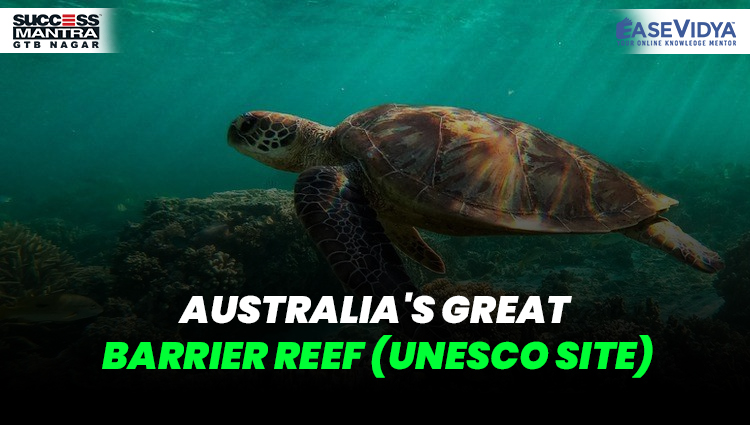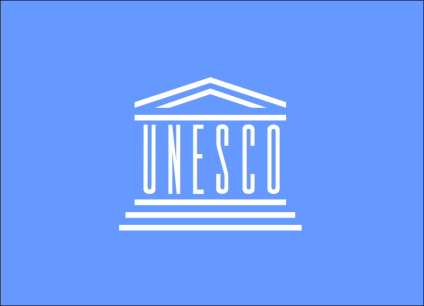
AUSTRALIA S GREAT BARRIER REEF UNESCO SITE
AUSTRALIA'S GREAT BARRIER REEF (UNESCO SITE)

Recently, the UNESCO World Heritage Committee has recommended that the Australia’s Great Barrier Reef should be added to a list of “in danger” World Heritage Sites. Placement on the ‘‘in-danger list’’ is not considered a sanction. Some nations have their sites added to gain international attention and help to save them.
Reason behind this Move: It was recommended to add to the list because of the impact of climate change. Despite Reef 2050, the coral reef ecosystem has suffered three major bleaching events since 2015 due to severe marine heatwaves. The Reef 2050 Long-Term Sustainability Plan is the Australian and Queensland Government’s overarching framework for protecting and managing the Great Barrier Reef by 2050. When corals face stress by changes in conditions such as temperature, light, or nutrients, they expel the symbiotic algae zooxanthellae living in their tissues, causing them to turn completely white. This phenomenon is called coral bleaching. Marine heatwave is an event of anomalous warm sea surface temperatures (SST) from several days to years.
Repercussions: It prompted environmental groups to take aim at the Australian government's reluctance to take stronger climate action. Australia, which is one of the world's largest carbon emitters per capita, has remained reluctant to commit to stronger climate action and has cited jobs as a major reason to back the country's fossil fuel industries. It has not updated its climate goals since 2015.
ABOUT GREAT BARRIER REEF
It is the world’s most extensive and spectacular coral reef ecosystem composed of over 2,900 individual reefs and 900 islands. The reef is located in the Coral Sea (North-East Coast), off the coast of Queensland, Australia. It can be seen from outer space and is the world’s biggest single structure made by living organisms. This reef structure is composed of and built by billions of tiny organisms, known as coral polyps. They are made up of genetically identical organisms called polyps, which are tiny, soft-bodied organisms. At their base is a hard, protective limestone skeleton called a calicle, which forms the structure of coral reefs. These polyps have microscopic algae called zooxanthellae living within their tissues. The corals and algae have a mutualistic (symbiotic) relationship. It was selected as a World Heritage Site in 1981.
INITIATIVES TO PROTECT CORALS

A number of global initiatives are being taken to address the issues, like:
- International Coral Reef Initiative
- Global Coral Reef Monitoring Network (GCRMN)
- Global Coral Reef Alliance (GCRA)
- The Global Coral Reef R&D Accelerator Platform
- Similarly, the Ministry of Environment and Forests and Climate Change (MoEF&CC), India has included the studies on coral reefs under the Coastal Zone Studies (CZS).
In India, the Zoological Survey of India (ZSI), with help from Gujarat’s forest department, is attempting a process to restore coral reefs using “biorock” or mineral accretion technology. National Coastal Mission Programme, to protect and sustain coral reefs in the country.
LARGEST CORAL REEF AREA:
- Indonesia has the largest coral reef area in the world. India, Maldives, Sri Lanka and Chagos have the maximum coral reefs in South Asia. The Great Barrier Reef of the Queensland coast of Australia is the largest aggregation of coral reefs.
- Coral Reef Areas in India: India has four coral reef areas: Gulf of Mannar, Andaman and Nicobar Islands, Lakshadweep islands and the Gulf of Kutch.
- Benefits: Protect humanity from natural calamities. Provide revenue and employment through tourism and recreation. Provide habitats for fishes, starfish and sea anemones.
- Use: They are used in jewellery. Coral blocks are used for buildings and road construction. The lime supplied by corals is used in cement industries.
- Threats: Due to anthropogenic activities such as coastal development, destructive fishing methods and pollution from domestic and industrial sewage. Due to increased sedimentation, over-exploitation and recurring cyclones. Coral diseases such as black band and white band due to infectious microorganisms introduced by the human population that live on the coastal regions.
- Role of Mangroves: Mangrove forests play a crucial role in helping the coral reef system by acting as filters and providing protection from cyclones, storms and tsunamis.
WHAT IS UNESCO?

United Nations Educational, Scientific and Cultural Organization (UNESCO) is a specialized agency of the United Nations (UN). It seeks to build peace through international cooperation in Education, the Sciences and Culture. It is also a member of the United Nations Sustainable Development Group (UNSDG), a coalition of UN agencies and organizations aimed at fulfilling the Sustainable Development Goals (SDGs). UNESCO’s Headquarters are located in Paris and the Organization has more than 50 field offices around the world. It has 193 Members and 11 Associate Members (As of April 2020) and is governed by the General Conference and the Executive Board. Three UNESCO member states are not UN members: Cook Islands, Niue, and Palestine. While three UN member states (Israel, Liechtenstein, United States) are not UNESCO members.
UNESCO focuses on a set of objectives such as:
- Attaining quality education for all and lifelong learning
- Mobilizing science knowledge and policy for sustainable development
- Addressing emerging social and ethical challenges
- Fostering cultural diversity, intercultural dialogue and a culture of peace
- Building inclusive knowledge societies through information and communication
- Focuses on global priority areas - “Africa” and “Gender Equality”.
History: In 1942, during the Second World War, the governments of the European countries, which were confronting Germany and its allies, met in the United Kingdom for the Conference of Allied Ministers of Education (CAME). Upon the proposal of CAME, a United Nations Conference for the establishment of an educational and cultural organization was convened in London in November 1945. At the end of the conference, UNESCO was founded on 16 November 1945. The first session of the General Conference of UNESCO was held in Paris during November-December of 1946.
TEST YOURSELF
Q.1 Consider the given statements & state which of the following is/are correct in the reference to the Great Barrier Reef?
- It is the world’s most extensive and spectacular coral reef ecosystem composed of over 2,900 individual reefs and 900 islands.
- They are made up of genetically identical organisms called polyps, which are tiny, soft-bodied organisms.
- The Great Barrier reef was selected as a World Heritage Site in 2001: ANSWER
- None of the above
Q.2 India has four coral reef areas altogether. Consider the given options & state which of the following is not one of them?
- Dadra & Nagar Haveli: ANSWER
- Gulf of Mannar
- Andaman and Nicobar Islands
- None of the above
Q.3 Which of the following is a global initiatives are being taken to address the issues like protection of coral reefs?
- International Coral Reef Initiative
- Global Coral Reef Monitoring Network (GCRMN)
- Global Coral Reef Alliance (GCRA)
- All of the above: ANSWER
Q.4 Which of the following given statements is/are correct in the context of the World Heritage Sites of UNESCO (United Nations Educational, Scientific and Cultural Organization)?
- The sites are designated as having “outstanding universal value” under the Convention Concerning the Protection of the World Cultural and Natural Heritage 1992.
- It provides a framework for international cooperation in preserving and protecting cultural treasures and natural areas throughout the world: ANSWER
- There are two types of UNESCO'S world heritage sites which includes cultural & natural sites.
- All of the above
Q.5 Consider the following statements & state which of these are correct in reference to the objectives of the United Nations Educational, Scientific and Cultural Organization (UNESCO)?
- Attaining quality education for all and lifelong learning.
- Mobilizing science knowledge and policy for sustainable development.
- Addressing emerging social and ethical challenges & Fostering cultural diversity, intercultural dialogue and a culture of peace.
- I & III follows
- Only III follows
- I, II & III follows: ANSWER
- None of the above













0 Comment